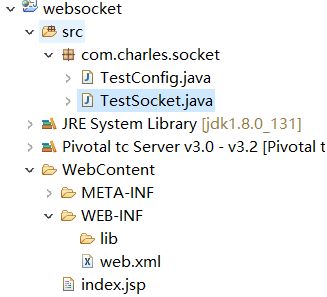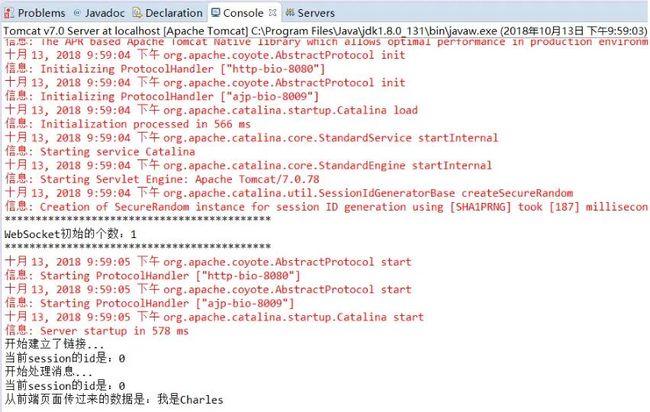使用websocket技术主动给前端发送消息
springBoot2.0对WebSocket的支持简直太棒了,直接就有包可以引入
org.springframework.boot
spring-boot-starter-websocket
WebSocketConfig
启用WebSocket的支持也是很简单
package com.spark.common.config;
import org.springframework.context.annotation.Bean;
import org.springframework.context.annotation.Configuration;
import org.springframework.web.socket.server.standard.ServerEndpointExporter;
/**
* @Author Lxq
* @Date 2021-06-12 17:11
* @Version 1.0
* 开启websocket支持
*/
@Configuration
public class WebSocketConfig {
@Bean
public ServerEndpointExporter serverEndpointExporter() {
return new ServerEndpointExporter();
}
}
WebSocketServer
这就是重点了,核心都在这里。
因为WebSocket是类似客户端服务端的形式(采用ws协议),那么这里的WebSocketServer其实就相当于一个ws协议的Controller
直接@ServerEndpoint("/socketServer/{userId}") 、@Component启用即可,然后在里面实现@OnOpen开启连接,@onClose关闭连接,@onMessage接收消息等方法。
新建一个ConcurrentHashMap webSocketMap 用于接收当前userId的WebSocket,方便IM之间对userId进行推送消息。单机版实现到这里就可以。
package com.spark.common.utils.websocket;
import com.alibaba.fastjson.JSON;
import com.alibaba.fastjson.JSONObject;
import com.spark.common.utils.StringUtils;
import lombok.extern.slf4j.Slf4j;
import org.springframework.stereotype.Component;
import javax.websocket.*;
import javax.websocket.server.PathParam;
import javax.websocket.server.ServerEndpoint;
import java.io.IOException;
import java.util.concurrent.ConcurrentHashMap;
/**
* @Author Lxq
* @Date 2021-06-12 17:13
* @Version 1.0
*/
@ServerEndpoint("/socketServer/{userId}")
@Component
@Slf4j
public class WebSocketServer {
/**
* 静态变量,用来记录当前在线连接数。应该把它设计成线程安全的。
*/
private static int onlineCount = 0;
/**
* concurrent包的线程安全Set,用来存放每个客户端对应的MyWebSocket对象。
*/
private static ConcurrentHashMap webSocketMap = new ConcurrentHashMap<>();
/**
* 与某个客户端的连接会话,需要通过它来给客户端发送数据
*/
private Session session;
/**
* 接收userId
*/
private String userId = "";
/**
* 连接建立成功调用的方法
*/
@OnOpen
public void onOpen(Session session, @PathParam("userId") String userId) {
this.session = session;
this.userId = userId;
if (webSocketMap.containsKey(userId)) {
webSocketMap.remove(userId);
webSocketMap.put(userId, this);
//加入set中
} else {
webSocketMap.put(userId, this);
//加入set中
addOnlineCount();
//在线数加1
}
log.info("用户连接:" + userId + ",当前在线人数为:" + getOnlineCount());
try {
sendMessage("连接成功");
} catch (IOException e) {
log.error("用户:" + userId + ",网络异常!");
}
}
/**
* 连接关闭调用的方法
*/
@OnClose
public void onClose() {
if (webSocketMap.containsKey(userId)) {
webSocketMap.remove(userId);
//从set中删除
subOnlineCount();
}
log.info("用户退出:" + userId + ",当前在线人数为:" + getOnlineCount());
}
/**
* 收到客户端消息后调用的方法
*
* @param message 客户端发送过来的消息
*/
@OnMessage
public void onMessage(String message, Session session) {
log.info("用户消息:" + userId + ",报文:" + message);
//可以群发消息
//消息保存到数据库、redis
if (StringUtils.isNotBlank(message)) {
try {
//解析发送的报文
JSONObject jsonObject = JSON.parseObject(message);
//追加发送人(防止串改)
jsonObject.put("fromUserId", this.userId);
String toUserId = jsonObject.getString("toUserId");
//传送给对应toUserId用户的websocket
if (StringUtils.isNotBlank(toUserId) && webSocketMap.containsKey(toUserId)) {
webSocketMap.get(toUserId).sendMessage(jsonObject.toJSONString());
} else {
log.error("请求的userId:" + toUserId + "不在该服务器上");
//否则不在这个服务器上,发送到mysql或者redis
}
} catch (Exception e) {
e.printStackTrace();
}
}
}
/**
* @param session
* @param error
*/
@OnError
public void onError(Session session, Throwable error) {
log.error("用户错误:" + this.userId + ",原因:" + error.getMessage());
error.printStackTrace();
}
/**
* 实现服务器主动推送
*/
public void sendMessage(String message) throws IOException {
this.session.getBasicRemote().sendText(message);
}
/**
* 发送自定义消息
*/
public static void sendInfo(String message, @PathParam("userId") String userId) throws IOException {
log.info("发送消息到:" + userId + ",报文:" + message);
if (StringUtils.isNotBlank(userId) && webSocketMap.containsKey(userId)) {
webSocketMap.get(userId).sendMessage(message);
} else {
log.error("用户" + userId + ",不在线!");
}
}
/**
* 获取当前在线人数
*
* @return
*/
public static synchronized int getOnlineCount() {
return onlineCount;
}
/**
* 添加人数
*/
public static synchronized void addOnlineCount() {
WebSocketServer.onlineCount++;
}
/**
* 减少人数
*/
public static synchronized void subOnlineCount() {
WebSocketServer.onlineCount--;
}
}
websocket基础入门-前端发送消息
项目结构如下图
TestSocket.java
package com.charles.socket;
import javax.websocket.OnMessage;
import javax.websocket.OnOpen;
import javax.websocket.Session;
import javax.websocket.server.ServerEndpoint;
@ServerEndpoint(value = "/helloSocket")
public class TestSocket {
/***
* 当建立链接时,调用的方法.
* @param session
*/
@OnOpen
public void open(Session session) {
System.out.println("开始建立了链接...");
System.out.println("当前session的id是:" + session.getId());
}
/***
* 处理消息的方法.
* @param session
*/
@OnMessage
public void message(Session session, String data) {
System.out.println("开始处理消息...");
System.out.println("当前session的id是:" + session.getId());
System.out.println("从前端页面传过来的数据是:" + data);
}
}
index.jsp 代码如下:
<%@ page language="java" contentType="text/html; charset=UTF-8" pageEncoding="UTF-8"%>Charles-WebSocket
注意:
和后台交互的时候,一定要先点击:开始建立连接。你懂的...没有建立连接的话,是不能发送消息的。
先点击,开始建立连接,然后在文本框中输入内容:我是Charles,点击消息发送,在看后台日志。
以上为个人经验,希望能给大家一个参考,也希望大家多多支持脚本之家。



